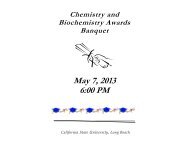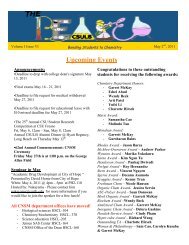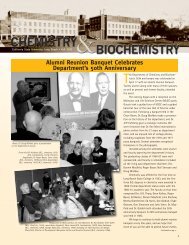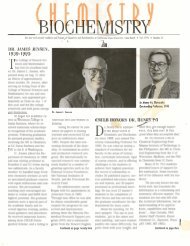2011 - California State University, Long Beach Department of ...
2011 - California State University, Long Beach Department of ...
2011 - California State University, Long Beach Department of ...
Create successful ePaper yourself
Turn your PDF publications into a flip-book with our unique Google optimized e-Paper software.
Photo by Rebecca Gardner<br />
Photo by David J. Nelson<br />
By Anne Ambrose<br />
10<br />
Chemistry and Biochemistry Faculty<br />
Five faculty members in the <strong>Department</strong> <strong>of</strong> Chemistry and Biochemistry were honored for their<br />
roles in the video series “Understanding Chemistry in Our World,” which won a 2010 Los<br />
Angeles Area Emmy Award for Best Instructional Series. Lecturer Nancy Gardner served as one<br />
<strong>of</strong> the project’s chemistry advisors and appeared in the series as a chemistry expert along with Drs.<br />
Stephen Mezyk, Paul Buonora, Brian McClain and Marco Lopez. The series, produced by Coast<br />
Learning Systems, accompanies a textbook, lab manual, and study guide also co-authored by<br />
Gardner as part <strong>of</strong> an online class for liberal arts majors. Coast Learning Systems is part <strong>of</strong> Orange<br />
County’s Coastline Community College. The series’ chemistry team was led by producers Wendy<br />
Rakochy, Marie Hulett (a CSULB alumna) and Laurie Melby, and writer Susan Wilcox.<br />
“I am honored to have worked and learned from this team on their 19th Emmy-winning project,”<br />
Gardner said.<br />
Win Emmy Award<br />
L.A. Area Emmy Awards 2010 ceremony attendees included (left to right) Susan Wilcox, Joan Stover, Nancy Gardner,<br />
Wendy Rakochy, CSULB alumni Jeff Isbell and Marie Hulett, and Mark Abdou.<br />
Xiao Wong<br />
Staff<br />
News<br />
Xiao Wong is the new administrative support assistant<br />
in the department <strong>of</strong>fice. Xiao is a native <strong>of</strong> Chinatown in Los<br />
Angeles, who received a B.A. in recreation and leisure studies<br />
with a certificate in gerontology from CSULB in 2010. She<br />
spent five years working as a student assistant in the<br />
<strong>Department</strong> <strong>of</strong> Physics before moving to the <strong>Department</strong> <strong>of</strong><br />
Chemistry and Biochemistry last August. Xiao enjoys<br />
swimming and has a passion for doing volunteer work in her<br />
home community.<br />
George “Buddy” Saxon, our former administrative<br />
support coordinator, has taken a position as administrative<br />
support coordinator for the <strong>Department</strong> <strong>of</strong> Communication<br />
Studies at <strong>California</strong> <strong>State</strong> <strong>University</strong>, Stanislaus.<br />
Reports from Faculty<br />
Continued from pg. 9<br />
I would be happy to hear from past students<br />
to know how you are doing. My e-mail<br />
address is: tmaricic@csulb.edu. Emeritus faculty<br />
don’t have university phones, so you can<br />
reach me on my cell phone at 562-209-4306.<br />
Dr. Douglas McAbee<br />
This past May marked the end <strong>of</strong> my<br />
14th year in this department. Last fall, I<br />
taught Chemical Communications (CHEM 361)<br />
for the first time. This relatively new course,<br />
which is required for all <strong>of</strong> our undergraduate<br />
majors, was developed about five years ago by<br />
Dr. Dot Goldish at my request as department<br />
chair. So, as the saying “what goes around,<br />
comes around” goes, it was only fitting that I<br />
should teach the course at some point. Even<br />
though it was a new experience for me, I<br />
enjoyed the challenge <strong>of</strong> getting students to<br />
think seriously and critically about clear communication.<br />
I must publicly acknowledge Dr.<br />
Goldish and Dr. Marco Lopez for providing me<br />
with ample course material, on which I relied<br />
heavily. As no good deed goes unpunished, I<br />
get to teach the class again this fall! Seriously,<br />
I’m looking forward to it. This past spring, it<br />
was a pleasure to teach my graduate Cell<br />
Membranes course. I’m not sure what the students<br />
got out <strong>of</strong> it, but I learned a lot! Biochemistry<br />
Laboratory (CHEM 443) was (mostly)<br />
fun this past year: most <strong>of</strong> the experiments<br />
worked, no one got hurt and no one threw<br />
their hemoglobin away (though some felt that<br />
impulse). And we made CHEM 443 lab T-shirts<br />
that everyone agreed were really cool.<br />
Jeremy Wood, a former biochemistry student,<br />
left my lab last summer and started his<br />
Ph.D. program in biochemistry and molecular<br />
biology at Texas A&M <strong>University</strong>. Jeremy<br />
advanced the project identifying human serum<br />
lact<strong>of</strong>errin-binding proteins and presented his<br />
work at the FASEB meetings in Anaheim,<br />
Calif., last April. Jeremy will do very well in his<br />
research and graduate courses, but the<br />
weather in College Station may kill him. And if<br />
he’s not careful, he may develop a Texas hill<br />
country accent. I was fortunate to obtain a<br />
mini-grant from the university late this spring,<br />
which I am using to expand work begun by<br />
Aynur Bakirci, a former M.S. degree student in<br />
the lab, to study the effects <strong>of</strong> acute iron<br />
overload on the rat liver proteome. Erik Anderson,<br />
an undergraduate biology student, is<br />
assisting me with the analysis. Wendy Beck,<br />
an erstwhile refugee from Dr. Paul Weers’ lab,<br />
is also learning to do two-dimensional gel


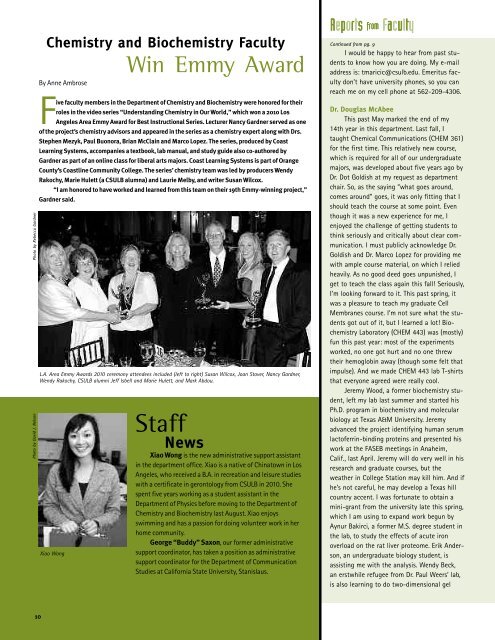
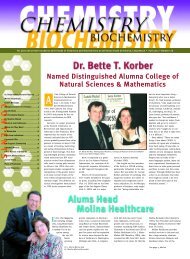
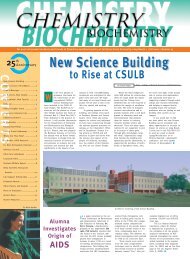
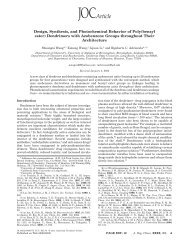
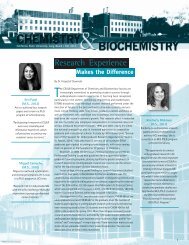
![Volume 4, Issue 3 [November 2012 pdf] - California State University ...](https://img.yumpu.com/34605825/1/190x245/volume-4-issue-3-november-2012-pdf-california-state-university-.jpg?quality=85)
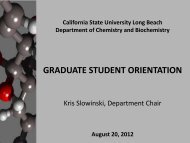
![Volume 5, Issue 2 [April 2013 pdf] - California State University, Long ...](https://img.yumpu.com/33273195/1/190x245/volume-5-issue-2-april-2013-pdf-california-state-university-long-.jpg?quality=85)
